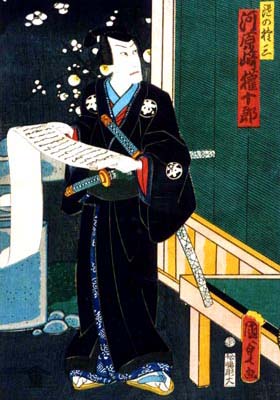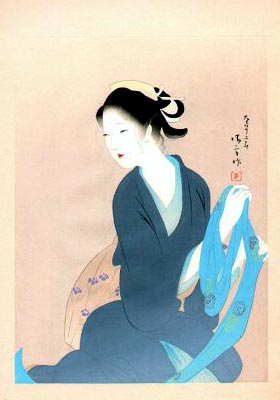| YARI NO GONZA |
| Play title | Yari no Gonza Kasane Katabira |
| Authors | Chikamatsu Monzaemon |
| History |
The puppet play "Yari no Gonza Kasane Katabira" was premiered in the 8th lunar month of 1717 in ďsaka at the Takemotoza. It was based on real events, which occurred in ďsaka in the 7th lunar month of 1717. The character of Yari no Gonza (or Sasano Gonza) appeared in a few Kabuki dramas during the Edo period. "Yari no Gonza Kasane Katabira" was revived by both the puppet theater and the Kabuki theater during modern times. It was for example revived at the National Theatre in April 1967 [casting]. |
| Structure |
The current Kabuki version of "Yari no Gonza Kasane Katabira" is made up of three acts. |
| Key words |
Chikamatsu San Kantsűmono Gidayű Ky˘gen Kantsű Kantsűmono Megatakiuchi Sewamono |
| Summary |
Gonza was a handsome youth in the service of a noble household. He was loved by a maiden called Oyuki, who had presented him with a special sash as a token of her affections. His position was complicated by the fact that her brother Bannoj˘ was hostile to Gonza and only too anxious to get him into trouble. Both men were students of the same tea-ceremony master. When the instructor had to make an official journey he selected Gonza to act as his deputy at a special occasion in the mansion where the handsome pupil was in service. In order to qualify for his task, Gonza was ordered to go to the wife of the absent tea master and be initiated into some special secrets of the art. The tea ceremony in Japan is an aesthetic ritual created to express love of beauty, simplicity, and tranquillity of the mind. It is characterized by slow, graceful, and extremely formalized movements. At the time of the play it was a vital part of cultural life and was practiced by most high-ranking people. Professional secrets of all arts and crafts were jealously guarded by teachers, especially as there were various "schools," each with its own subtleties of method. These facts explain what might seem to be rather a pother about nothing to the Western reader. Osai, the wife of the instructor, had designs on the handsome Gonza as a future husband for her small daughter. It was quite common for parents to make matches for their daughters years before they were of age to be married. When Gonza went to call on Osai, she proposed to teach him the secrets of her husband's art if he would agree to become betrothed to her small daughter. Presented with a difficult situation and anxious to secure his professional advancement, Gonza agreed to the bargain. Osai arranged for him to call on her late at night to prevent inquisitive ears and eyes from knowing that important secrets were being transferred. While Gonza was calling on Osai another visitor arrived in the person of his sweetheart Oyuki's old nurse. She was received by Osai's maid, who passed on a request from the nurse after Gonza had left. Briefly it was this: as her young mistress was in love with Gonza, and had given him a sash as a love token, the old nurse wanted to see them married and asked Osai to be the go-between. When Osai received the message she was acutely disappointed and became extremely jealous on her daughter's behalf. Gonza went for his instruction late at night as arranged, but the scheming Bannoj˘ and an accomplice followed to spy on the secret meeting. Towards the end of the lesson Osai, unable to restrain her jealousy, quarrelled with Gonza, tore off Oyuki's sash, which he was wearing, and tossed it into the garden where Bannoj˘ and his man were hiding. Overcome with a frenzy of anger, she further wrenched off her own sash and hurled it at Gonza, who bad temperedly threw it into the garden after the other one. In Japanese etiquette it was the height of immorality for a woman to undo her sash in front of a man. The gleeful Bannoj˘ caught the incriminating article. Gonza, hearing noises and realizing they were being spied upon, leapt into the garden. He collided with Bannoj˘'s accomplice in the dark and ran him through with his sword. But Bannoj˘ had already escaped to spread his slanders. Gonza and Osai realized that they were now hopelessly compromised. They would be accused of adultery, and no one would ever believe them innocent. Adultery was punishable by death. The one course left to them was to flee together. After an emotional scene they disappeared into the night. On the night of the Bon Festival, when the Edo townspeople were out dancing in the streets, the two fugitives were finally discovered by the questing tea-ceremony master and a companion. Osai was killed by her husband on the spot, and after a fierce duel with his two assailants Gonza was finally cut down and fell dead across the lifeless body of Osai. Source: A. C. Scott |
 |
 |
|
Kawarasaki Gonjűr˘ I portraying Yari no Gonza in a print made by Utagawa Kunisada II in 1863 |
Osai in a print made by Kaburagi Kiyokata around 1923 |
|
|
| Contact | Main | Top | Updates | Actors | Plays | Playwrights | Programs | Links | FAQ | Glossary | Chronology | Illustrations | Prints | Characters | Derivatives | Theaters | Coming soon | News |